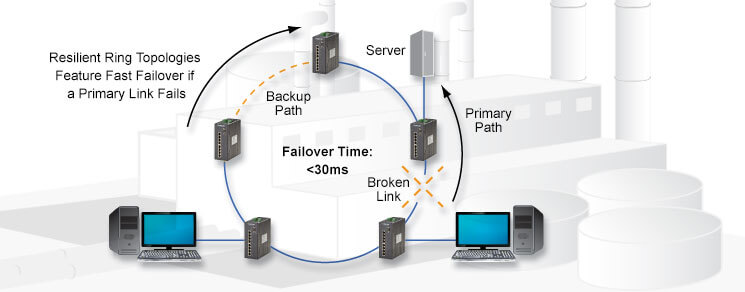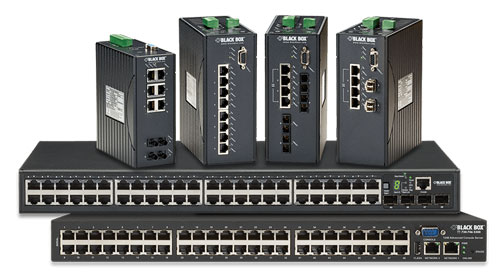The Difference between a Managed, Unmanaged Switch, and Web Smart Switch

With regard to management options, the three primary classes of switches are Unmanaged Switches, Managed Switches, and Web Smart switches. Which you choose depends largely on the size of your network and how much control you need over that network.
Managed Switches provide configuration possibilities that can modify and manage their operation, which is especially valuable when diagnosing problems, when you have multicast traffic on your network and when downtime is expensive, proving there are added benefits to using managed switches. On the other hand, Unmanaged switches are an affordable solution but do not offer such features and work on a plug-and-play basis with neither interface, nor option to modify their operation.
It's also important to select an adequate switch depending on their specific application, in an industrial setting with rugged environments, for instance, Industrial Ethernet Switches will give you the high reliability you need for mission-critical networks with the harshest outdoor conditions.
TYPES OF SWITCHES
Web smart switches—sometimes called smart switches or Web managed switches—have become a popular option for mid-sized networks that require management. They offer access to switch management features such as port monitoring, link aggregation, and VPN through a simple Web interface via an embedded Web browser. What these switches generally do not have is SNMP management capabilities or a CLI. Web-smart switches must usually be managed individually rather than in groups.
Although the management features found in a Web-smart switch are less extensive than those found in a fully managed switch, these switches are becoming smarter, now offering many of the features of a fully managed switch.
Unmanaged switches are basic plug-and-play switches with no remote configuration, management, or monitoring options, although many can be locally monitored and configured via LED indicators and DIP switches. These inexpensive switches are typically used in small networks or to add temporary workgroups to larger networks.
Unmanaged switches are plug and play devices without the need of a complex setup. These switches allow Ethernet devices to communicate with one another (such as a PC or network printer) by providing a connection to the network and passing on information to where it needs to go. They come with a fixed configuration and do not allow any changes to this configuration, therefore, there is no need for prioritising the packets. They can be desktop or rack mounted and are a less expensive option for connectivity switching needs.
One major setback within an industrial setting is that they don’t support IGMP and treat multicast traffic in the same fashion as broadcast traffic, which can overwhelm a network when uncontrolled and lead to broadcast storms. This feature is particularly important on industrial networks because the protocol Ethernet/IP relies heavily on multicast traffic.
When and where to use?
Unmanaged switches are mostly used to connect edge devices on network spurs, or on a small stand-alone network with only a few components. It’s suitable for any business network that wants to simplify the installation of wireless access points and IP-based surveillance cameras. They are also applicable for home use, SOHO, small businesses or to add temporary workgroups to larger networks.
Is it possible to configure a managed switch as unmanaged?
It is possible to run a managed switch and use it out of the box just like an unmanaged switch. By operating the managed switch in "Open Mode", having no configuration set up, means the device will be set up to the default VLAN where all ports are members of the default VLAN. The conveniences of purchasing a managed switch is that if you later desire to change the config you can still do and start vlanning the section of your network you’d wish for your specific networking needs.
Potential Applications for Unmanaged Ethernet Switches
Maritime - Automation and monitoring
- Allow for an Ethernet environment with fibre which offers reliable remote monitoring functionality and reduces the number of service calls needed.
- Having remote access, control, and monitoring from anywhere, anytime.
Energy - Automation and monitoring
- Fulfil the long-haul data transmission to large scale factories, making it easier to configure and support high-speed data transfer between machines or to the central control room.
- Providing long distance fibre transmission for wind farm networks spread across vast distances.
Managed Switches are oriented towards redundancy as they provide QoS (Quality of Service) which prioritises bandwidth for data subsets, allowing more bandwidth to be allocated through the network to ensure IP data comes in smoothly, obtaining the sensor data without an interruption using minimal bandwidth. Managed switches support Simple Network Management Protocol (SNMP) via embedded agents and have a command line interface (CLI) that can be accessed via serial console, Telnet, and Secure Shell. These switches can often be configured and managed as groups. Managed switches also provide additional protocols like RSTP (Rapid Spanning Tree Protocol) allowing alternate cabling paths and preventing loop situations which usually are the reason for network malfunctions. A managed switch offers redundancy capabilities which helps to reduce unplanned downtime. Managed switches also offer powerful features like VLANs, LACP, as well as all advanced filter and multicast algorithms needed today to easily prioritise, partition and organise a reliable high-speed network. The conveniences of purchasing a managed switch is that if you later desire to change the config you can still do so and start vlanning the section of your network you’d wish for your specific networking needs.
When and where to use?
Managed switches are aimed at users that require a response time of milliseconds. They are especially suitable for organisations that need to manage and troubleshoot their network remotely and securely; allowing network managers to reach optimal network performance and reliability.
Managed switches should be used on any network or segment of a network where the traffic has to be monitored and controlled. Managed network switches enable complete control of data, bandwidth and traffic control. Some switches come equipped with SFP slots, which allow the network to be expanded with flexibility.The benefit of having multi-rate SFP slots is to be able to use 100Mbps and 1Gbps SFP Modules for either multi-mode or single-mode in a mix and match as needed. If requirements change, it´s possible to replace the SFP module and protect your switch investment.

Resilient Ring Topologies Feature Fast Failover if a Primary Links Fails
Potential Applications for Managed Ethernet Switches
Transportation - Intelligent transportation systems (ITS)
- A system that allows centralised management of traffic over the metropolitan regions of a city
- Gigabit fibre optic network using Ethernet switches with several nodes spread out over metropolitan regions, for long distance and high bandwidth requirements
Mission Critical Settings - Monitoring and Control
- Ensuring alarm sensors exchange signals over Ethernet connected to a control centre
- By utilising the existing fibre network, Input/output signals can be transferred without additional wiring effort
Within industrial settings, there is a need to have switches prepared for particular needs. Industrial switches are specially designed for various network connections such as distribution of energy in electric substations as well as monitoring and controlling security camera functions in the field as many other applications.
Industrial Ethernet Switches establish network connectivity between industrial environments and enterprise business applications. Made for Industrial use, these types of switches are targeted for mission-critical applications, designed to withstand extreme temperatures and harsh conditions in a multitude of environments from factory floors to traffic controls. In demanding settings, a useful characteristic of managed industrial switches is the ability to configure its settings to VLAN mode. This makes it possible to group devices per working department (eg. IT/Logistics), isolate traffic between these groups so that critical information can flow without delay to the rightfully allocated place, and increase the security level of the network.

When and where to use?
Industrial switches are specifically designed to stand up to extreme temperatures (-40 up to +85°), vibrations, and shocks, contributing to a cost-effective, reliable secure network. These switches give your network new ways to route data if a specific point of your network fails. When using redundancy, the network is able to quickly maintain communication without interruption.
Industrial Switches characteristics
| Mounting Options |
DIN rail, panel |
| Environment |
Harsh environment including factories, oil/gas fields, military vehicles/ships, HVAC controls, security and surveillance, and more. |
| Operating Temp. |
Extended |
| Cooling |
Convection cooling with limited ingress points |
| Power |
DC input for safety inside the panel |
| Packaging |
Designed to withstand high shock and vibrations |
Industrial switches are especially suitable for applications where there is a need to:
- Prioritise, partition and organise a reliable high-speed network
- Deliver video and other corporate applications to a manufacturing plant floor
- Maximise availability for distributed control systems, without compromising on quality, reliability and safety
- Provide a large throughput and reduce the response time for sensitive applications like video and/or voice mixed with data in the same pipeline designed to support standard industrial applications without the need of a complex setup
- Offer cyber security features to enhance the network security at no extra cost
- Reduce downtime with a simple switchover from unmanaged to industrial managed Ethernet switch
Within industrial settings context, in harsh environments, it’s relevant to stress the importance of Power Over Ethernet (PoE). PoE switches can remotely provide power to devices, free from restrictions imposed by limited AC outlets. This allows to centralise power distribution and backup power. PoE switches supply power to devices under a vast array of settings. This can range from security surveillance applications, VoIP phones, backhauling IP camera traffic and wifi access point traffic, or also using fiber for extended reach in applications such as outdoors, distribution warehouses, retail video kiosks, smart signs and retail point-of-information systems. All in all, PoE switches simplify the use of devices in in hard-to-reach, outdoor and remote areas and can save up to 700€-1500€ per Access Point (AP).
Subscribe our Newsletter
Related Products

 In order to find out more about all upcoming Black Box developments around networking please
In order to find out more about all upcoming Black Box developments around networking please